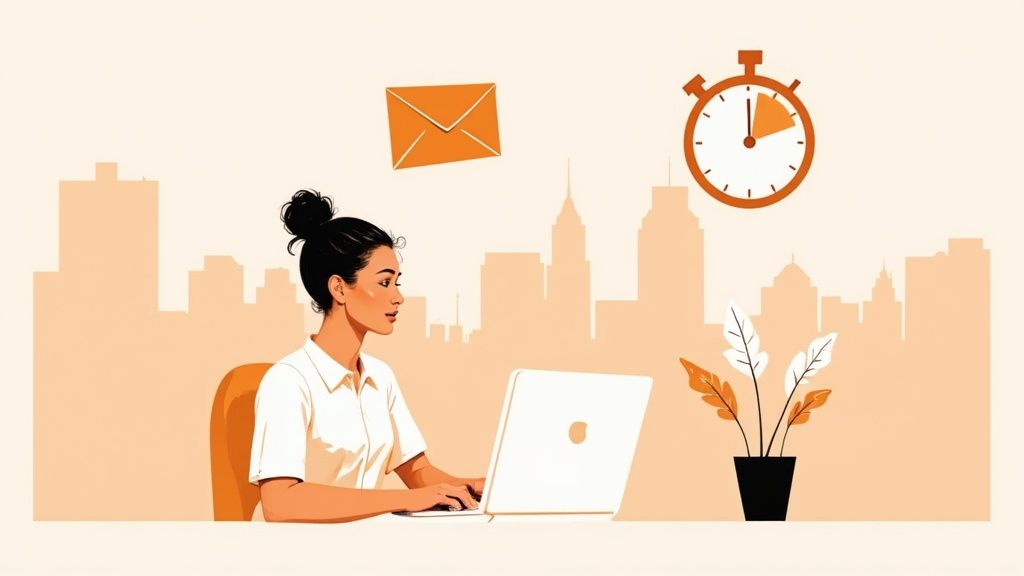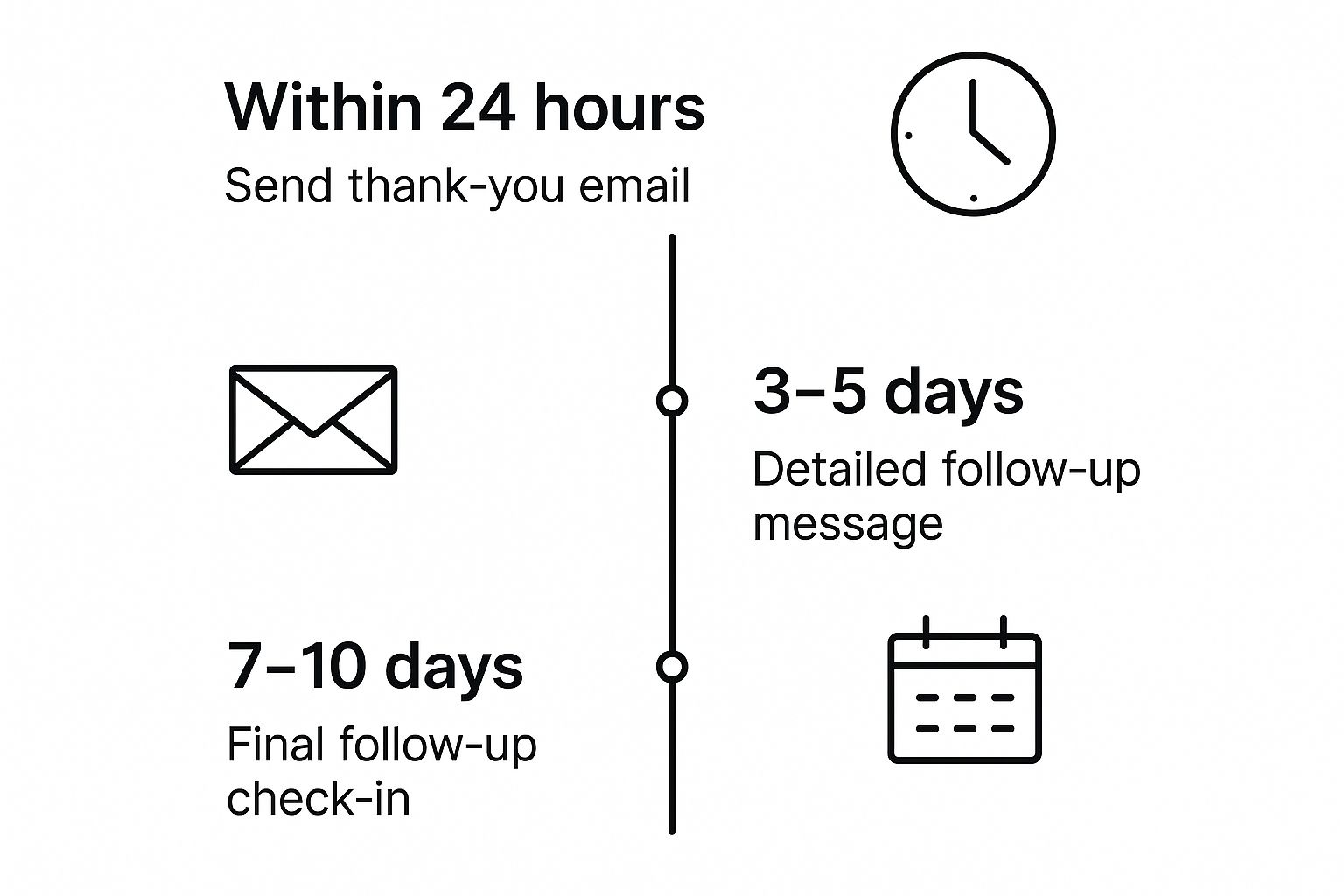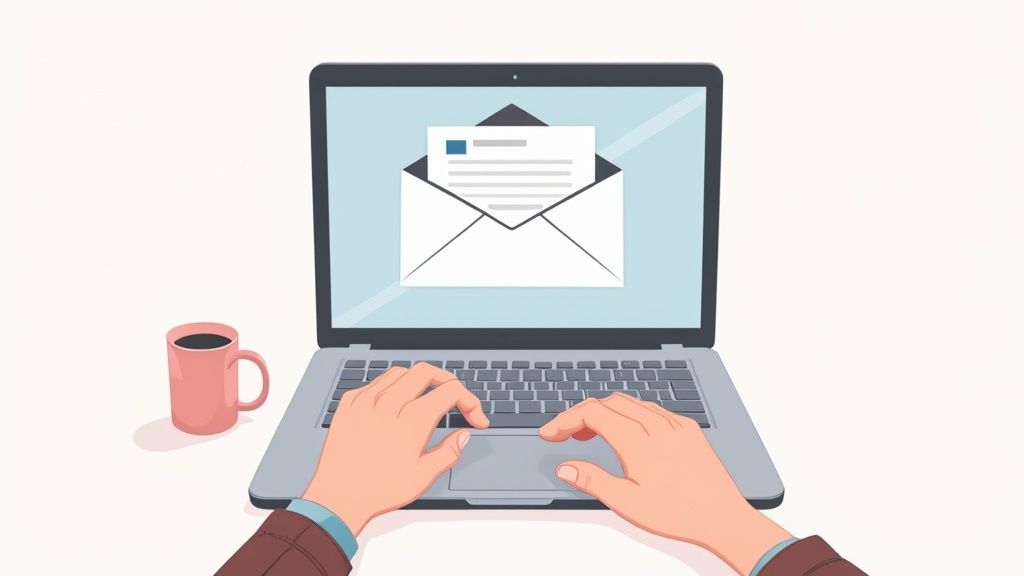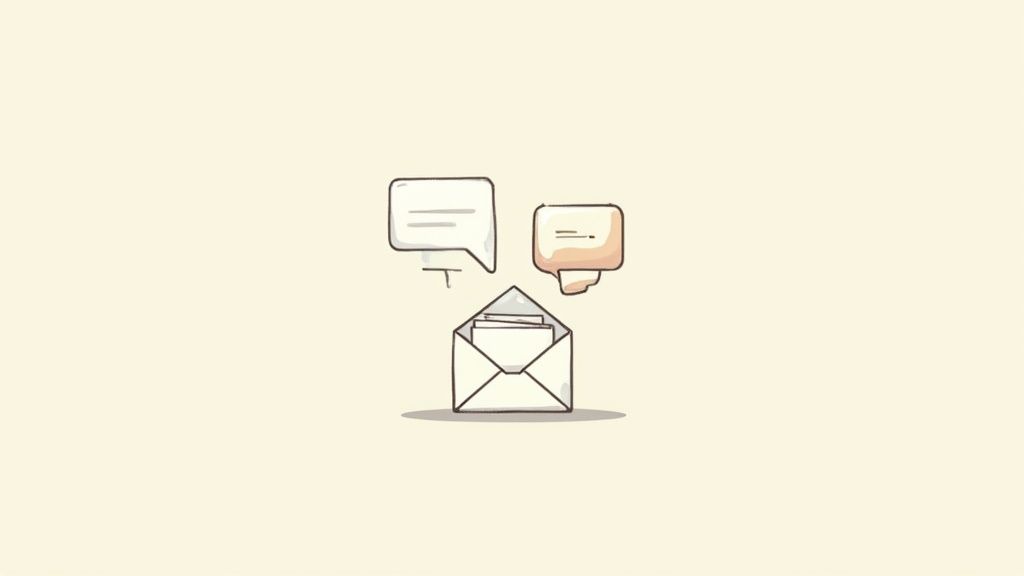
How to Follow Up After Interview - Tips to Get Noticed
You’ve nailed the interview. Great! But don’t close your laptop just yet. The next 24 hours are critical. Sending a personalized thank-you email isn’t just polite—it’s a strategic move that keeps the conversation going, reminds them why you’re a great fit, and can genuinely tip the scales in your favor. It’s a small action with a huge potential payoff.
Why Your Post-Interview Follow-Up Is a Game Changer
Think of it this way: the evaluation doesn’t stop when you walk out the door (or log off the video call). In a crowded field of applicants, what you do after the interview can be just as telling as what you did during it. A thoughtful follow-up is your last, best chance to separate yourself from other qualified candidates.
This isn’t just about checking a box for good manners. It’s a professional power play. A well-written message showcases your communication skills and attention to detail. More importantly, it proves you were listening by giving you a chance to reference specific things you discussed, showing your genuine interest in the role and the company.
The Impact on Hiring Decisions
Your follow-up has a real psychological effect. It keeps you top-of-mind while the hiring manager is weighing their options. The numbers don’t lie, either. This one simple gesture can be the deciding factor.
A staggering 86% of hiring managers admit that receiving a thank-you note influences their decision-making process. Yet, here’s the kicker: only about one in five candidates who interview actually land the job. This points to a massive opportunity to get a leg up on the other 80% of applicants who don’t make the cut. You can dive deeper into these and other compelling job interview statistics.
The timeline below gives you a clear picture of the key moments to communicate effectively, helping you stay on their radar without coming across as pushy.

Here’s a quick cheat sheet to help you map out your communication strategy.
Your Post-Interview Follow-Up Timeline
This table provides a quick reference for the key follow-up actions and when to take them to maintain momentum without being pushy.
| Action | Recommended Timing | Your Goal |
|---|---|---|
| The Thank-You Email | Within 24 hours of the interview | Reinforce interest, show gratitude, and recap key strengths. |
| The First Check-In | 1-2 weeks after the interview (or after their stated deadline) | Gently inquire about the timeline and express continued enthusiasm. |
| The “Keeping in Touch” Message | 2-4 weeks after the last communication | Maintain a positive connection and stay on their radar for future roles. |
Following this cadence helps you navigate the post-interview waiting game with confidence and professionalism.
By mastering the follow-up, you’re not just sending an email; you’re completing your professional narrative. It’s the final piece of the puzzle that shows you’re the detail-oriented, proactive candidate they’ve been looking for. This small effort can turn a “maybe” into a definitive “yes.”
Mastering the Art of Follow-Up Timing

Sending a follow-up is standard practice, but when you send it is what can truly set you apart. The timing of your message speaks volumes about your professionalism and genuine interest. It’s a delicate dance between showing keen enthusiasm and respecting the hiring manager’s packed schedule.
That first thank-you note is the most time-sensitive. Firing it off just a few hours after the interview can feel a bit rushed, but waiting more than a day means the great conversation you had might start to fade from their memory. The sweet spot? Within 24 hours. It shows you’re prompt, organized, and thoughtful.
Pacing Your Follow-Ups
After that initial thank-you, your follow-up cadence needs a bit more patience. If the hiring manager gave you a specific date to expect an update, the rule is simple: respect it. Don’t even think about reaching out before that day has passed.
What if they didn’t give you a timeline? You’ll need a different approach. Hitting their inbox again just a few days later can come across as impatient. Interestingly, expert analysis suggests the ideal time for that second check-in is between the 8th and 10th day post-interview. For a third-round interview, however, that window tightens to about 4 to 5 days to keep the momentum going. You can dig into more effective follow-up timelines on VisualCV.
Think of your follow-up cadence like a friendly conversation, not an interrogation. Give them space to deliberate, but provide gentle reminders that you are still engaged and excited about the opportunity.
Organizing Your Communication
Juggling multiple applications, each with its own timeline, can get messy fast. This is where a simple tracking system becomes your best friend. Keeping a log of interview dates and when you sent each follow-up email for every role prevents slip-ups and ensures you always make your move at the perfect moment.
You can easily manage this with a dedicated job application tracking spreadsheet. This organized method lets you tailor your timing based on the interview stage—whether it was a quick phone screen or a final, in-depth meeting. It’s a small effort that makes a huge professional impact.
Writing a Follow-Up Email That Gets Read

Think of your follow-up email as your final sales pitch, not just a simple “thank you.” A generic, copy-pasted message is a missed opportunity. To actually get your email read and leave a lasting impression, you need to personalize it and show you’re still adding value.
It all starts with a subject line that’s clear, professional, and easy for a swamped hiring manager to spot. Forget vague phrases like “Following up” or “Thank you.” You need to be specific so they know exactly who you are and why you’re in their inbox.
Crafting a Compelling Subject Line
Your goal is to be instantly recognizable in a sea of emails. I’ve found these formats work best to get your message opened right away:
- Simple and Direct: “Thank you – [Job Title] Interview”
- Adding Your Name: “Follow-up regarding the [Job Title] role – [Your Name]”
- Referencing the Interviewer: “Thank you, [Interviewer’s Name]!”
This simple tweak ensures your email doesn’t get lost in the shuffle and sets a professional tone from the get-go. With that handled, the body of your email is where you really seal the deal.
The most effective follow-ups I’ve seen feel less like a template and more like a genuine continuation of the interview. You have to weave in specific details from your conversation to prove you were engaged and actually listening.
Did they mention a specific challenge with a new project? Did you bond over a shared interest in a new industry trend? Bringing these points up shows you have a real interest in the role and helps reignite the rapport you built. If you’re dealing directly with a recruiter, our guide on how to follow up with a recruiter has some specific tips for that dynamic.
Remember, the goal is to add value, not just ask for an update. Connect a specific skill or experience you have to a problem they mentioned. This reframes your follow-up from a simple thank you to a final, compelling piece of evidence that you are the right person for the job.
Structuring Your Message for Impact
Nobody wants to read a wall of text. Break your message into short, scannable paragraphs to respect the hiring manager’s time and make your key points pop.
Here’s a structure that I’ve seen work time and time again:
- The Opener: Start with a sincere thank you. Be sure to mention the specific role and the date you interviewed.
- The Connection: Reference a unique topic from your conversation that really stood out to you. This is your personalization hook.
- The Value-Add: Briefly connect one of your key skills to a company goal or challenge they mentioned. Show them you’re already thinking like a team member.
- The Close: Reiterate your strong interest and enthusiasm for the role, then close with a professional sign-off.
Following this framework turns your email from a polite formality into a powerful tool that reinforces your value and keeps you top-of-mind.
What to Do When You Hear Nothing Back
The silence after an interview can be maddening. You’ve already sent your thank-you note and the hiring manager said you’d hear back by Friday. Now it’s Tuesday, and all you hear is crickets.
It’s an experience we’ve all had, and it’s tempting to assume the worst. But before you spiral, remember that hiring is often chaotic behind the scenes. Unexpected delays, last-minute meetings, or a sudden shift in company priorities can easily throw off a timeline. Your gentle nudge might be exactly what a swamped hiring manager needs.
So, when is the right time to reach out again? A good rule of thumb is to wait at least two business days after the promised deadline has passed. If they never gave you a specific date, give it about a week from your last point of contact.
Sending a Polite Nudge
Your goal here is to be politely persistent, not a pest. Keep your message short, professional, and upbeat. Think of it less as a “Where’s my offer?” demand and more as a simple, friendly check-in.
A straightforward subject line like “Checking in on the [Job Title] role” works perfectly. In the email, just reiterate your interest and ask if they have any updates on their timeline. It’s a simple way to stay on their radar and show you’re still enthusiastic.
Silence doesn’t always mean “no.” A polite follow-up shows you’re organized, professional, and genuinely invested in the opportunity—all things a great employer looks for.
This isn’t just about good manners; it’s a strategic move. A single corporate job opening can pull in around 250 applications, but only about 2.4% of those people will actually get an interview. When the competition is that fierce, every professional touchpoint matters. For more on these numbers, check out this breakdown of what it takes to get an interview.
If you’ve built a decent rapport, you might even consider a different channel. A quick message on LinkedIn can sometimes feel a bit more casual and direct.
But what if another week goes by after your nudge and there’s still no word? At that point, it’s probably time to gracefully move on. It’s a tough pill to swallow, but channeling your energy into the next great opportunity is a much better use of your time.
Next-Level Follow-Up Strategies That Impress

A simple thank-you note checks a box. But if you really want to make a lasting impression, you have to go beyond the expected. The goal is to show them you’re not just saying you’re a great fit—you’re already thinking like a member of the team.
This is your chance to add real value. Think back to your conversation. Did you touch on a specific industry trend or a challenge the company is facing? Follow up with a link to a fascinating article on that topic, adding a sentence or two with your own thoughts. It’s a small gesture, but it proves you’re engaged, proactive, and genuinely invested in their world.
Tailoring Your Approach to the Audience
Not every follow-up should be the same, because you’re not talking to the same person. Your message to the HR coordinator needs a different touch than the one you send to your potential boss.
- The HR Coordinator: Your note should be professional and centered on the hiring process. Thank them for their time, express your continued enthusiasm for the company, and politely ask about the timeline for next steps.
- The Hiring Manager: This is where you can be more strategic. Reference a specific business challenge they brought up during the interview and offer a quick, high-level idea or a link to a resource that addresses it.
- A Future Teammate: You can be a bit more casual here. A friendly note mentioning how much you enjoyed hearing about their work on the team can go a long way in building rapport.
This kind of targeted communication shows you understand how organizations work and that you respect each person’s role. It’s a subtle move that signals a high degree of professional savvy. For more on building these professional connections, our guide on how to optimize your LinkedIn profile has some great tips.
The most impactful follow-ups shift the conversation from “I want this job” to “Here’s how I can help solve your problems.” When you add value, you’re no longer just a candidate; you’re a potential partner.
Let’s say you’re a graphic designer. In the interview, the manager mentions they’re struggling to boost social media engagement. Imagine their surprise when your follow-up email includes a slick, unsolicited mock-up for an Instagram post that’s perfectly on-brand. It’s a bold move, for sure. But it’s the kind of initiative that makes you unforgettable.
Your Top Interview Follow-Up Questions, Answered
Walking out of an interview can feel like stepping onto a tightrope. You want to stay on the hiring manager’s radar, but you’re worried about being too present. Annoying? Impatient? These are the worries that keep candidates up at night.
Let’s clear the air. Here are some straightforward answers to the tricky situations every job seeker runs into after an interview. You’ll know exactly what to do and say to reinforce your professionalism and keep your candidacy strong.
Should I Email Every Single Person I Interviewed With?
Yes, you absolutely should. This is one of those small details that makes a huge difference. It shows you’re thorough and that you genuinely appreciated everyone’s time.
Your core message can be the same across the emails, but each one needs a personal touch. Try to mention something specific you talked about with that individual—a project they mentioned, a question they asked, or a shared interest. This proves you were engaged and not just going through the motions.
What if you don’t have their email addresses? No problem. Just send a single, polite note to your main contact (usually the recruiter or hiring manager) and ask them to pass your thanks along to the rest of the team.
A personalized thank-you to each interviewer isn’t just good manners—it’s a strategic move. You’re building individual rapport and showing them you see them as people, not just hurdles in the hiring process.
Is It Okay to Connect on LinkedIn After an Interview?
Connecting on LinkedIn is a smart move for staying on their professional radar, but the timing is crucial. The golden rule here is to send your thank-you email first. Let that be your immediate, official follow-up.
Give it a day or two, then send the connection request. And whatever you do, don’t send a blank one. It just feels impersonal after you’ve just had a full conversation. Always add a short, personalized note.
- What to say: “Hi [Name], I really enjoyed our conversation on [Day] about the [Job Title] role. I’d love to connect here.”
- What to avoid: The default, empty request. It comes across as low-effort.
This two-step approach keeps things professional and avoids putting any pressure on the interviewer.
They Said I’d Hear by Tuesday… It’s Thursday. What Now?
First, don’t panic. This happens all the time. If the hiring manager gave you a specific date and that day has come and gone, it’s perfectly fine to check in. Just give them a little breathing room—wait one or two business days after the missed deadline before you send a nudge.
Your email should be polite, brief, and completely free of any “you said…” accusations. The goal is to show your continued interest, not to call them out.
A simple, friendly check-in is all you need: “I’m writing to express my continued interest in the role and wanted to check in for any updates on the timeline.” That’s it. You sound proactive and engaged, not demanding.
Stop drowning in a sea of applications. With Jobcamp, you can generate tailored resumes and cover letters in seconds, track every application, and get the insights you need to land your next interview faster. Take control of your job search at https://www.jobcamp.ai.

